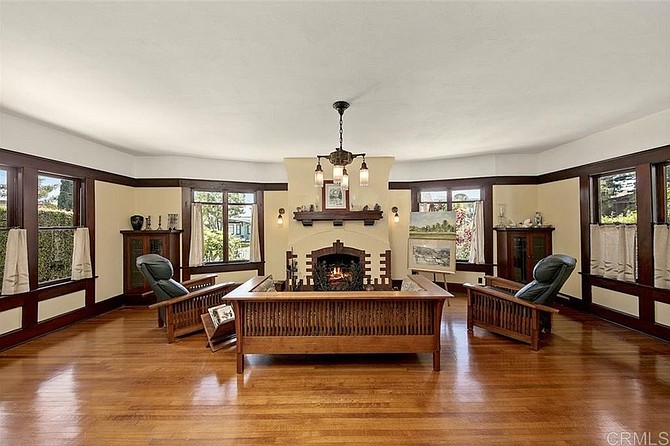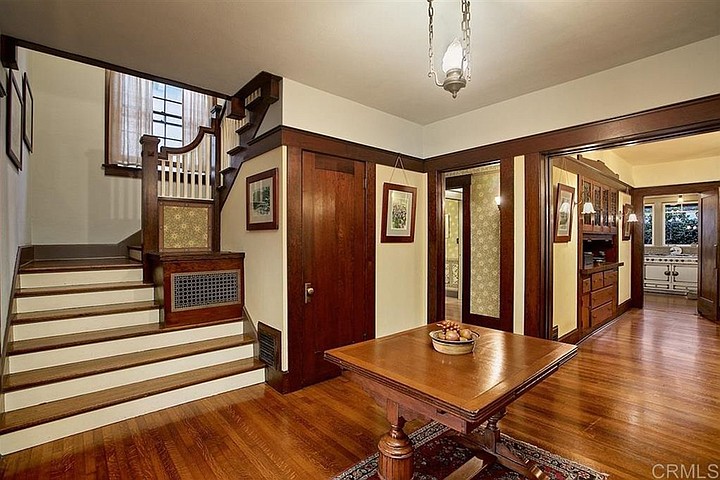 Facebook
Facebook
 X
X
 Instagram
Instagram
 TikTok
TikTok
 Youtube
Youtube

The Harrison G. Otis House, a Mission Hills mansion with nearly 3900 square feet of living space, was originally built in 1910. Per listing materials retrieved from Realtor.com, “historic details abound” throughout the home.
Commissioned by A.F. Hunt, an official with the Santa Fe Railway, the home was designed by G.A. Hanssen, a local architect who created a host of historically-designated buildings including both the Otis House and the Yuma County Courthouse in Yuma, Arizona. Sited along what was once known as San Diego’s “Lawyers’ Block,” the home was more closely associated with West Point cavalry officer Otis, who shared a name with but was not related to the Harrison Gray Otis who published the Los Angeles Times for several decades in the late nineteenth and early twentieth century. Per listing materials, the home remained in the Otis family until 1975.
The family kept the Tudor Revival residence “maintained to early original condition” throughout their ownership. Much of the craftsmanship and styling cues of the era remain on display today, including “original wood floors and vertical-grain, old-growth Douglas fir woodwork throughout, picture rails, a built-in china cabinet in the formal dining room” and “leaded glass doors repeating the front door stained glass pattern opening onto the formal entry leading to the main stairs.”
A grand fireplace in the living room is constructed from clinker brick — bricks originally rejected by builders for their non-uniform shape and color, but prized by early interior designers for their uniqueness. It’s flanked by built-in leaded glass bookcases. These are fixed in place, but others leading up to the attic-level library and bedroom suite slide aside to reveal a hidden storage space.

The chef’s kitchen has been updated with retro-look modern appliances from Le Cornue and Gaggenau and “maintains its charm by incorporating the original butler’s pantry cabinetry” while providing for easy entertainment with windows that open onto a “lush patio and garden complete with fountain and retractable awning.” The original maid’s quarters have been converted to a “generous laundry room,” but period-specific wallpaper and an original early-1900s John Douglas toilet keep the downstairs half-bath and telephone room true to the home’s vintage.
The primary master suite sits on the second floor, and still houses its original wall safe and brass speaking tube, a means of communicating with servants in the era before telephones or intercom systems. (A separate staircase between the basement and first two levels would have further served to hide domestic staff who’d otherwise use the grand wood-lined stairwell). There’s also a sewing room with French doors leading to a balcony and a separate “gentleman’s quarters” adjacent to the suite, while the “spa-like en suite includes clawfoot tub, separate shower, and ‘Pacific’ toilet.”
“West facing windows open to face San Diego harbor and breathtaking sunsets,” while “true-to-the-era landscaping boasts fruit trees, assorted flowers, and rose garden” along with copper gutters, fountains, and a “huge front porch with views of passersby, all lend to comfortable outdoor living space.”
“Captivating and elegant, the Otis House is an enchanting piece of history waiting to be called home.”
Public records indicate ownership of the Otis House currently lies with Jonathan Durnford and Marianne Ries, both local professionals. While the house last sold in 2011 for a reported $1,358,000, the county assessor values it at just under $296,000 thanks to a significant tax savings afforded by the Mills Act to owners who maintain historic buildings with their original architecture. Similar tax benefits would transfer to a new buyer.
The house was listed for sale in late May after nearly a decade off-market. Its asking price of $1,895,000 remains unchanged to date.


The Harrison G. Otis House, a Mission Hills mansion with nearly 3900 square feet of living space, was originally built in 1910. Per listing materials retrieved from Realtor.com, “historic details abound” throughout the home.
Commissioned by A.F. Hunt, an official with the Santa Fe Railway, the home was designed by G.A. Hanssen, a local architect who created a host of historically-designated buildings including both the Otis House and the Yuma County Courthouse in Yuma, Arizona. Sited along what was once known as San Diego’s “Lawyers’ Block,” the home was more closely associated with West Point cavalry officer Otis, who shared a name with but was not related to the Harrison Gray Otis who published the Los Angeles Times for several decades in the late nineteenth and early twentieth century. Per listing materials, the home remained in the Otis family until 1975.
The family kept the Tudor Revival residence “maintained to early original condition” throughout their ownership. Much of the craftsmanship and styling cues of the era remain on display today, including “original wood floors and vertical-grain, old-growth Douglas fir woodwork throughout, picture rails, a built-in china cabinet in the formal dining room” and “leaded glass doors repeating the front door stained glass pattern opening onto the formal entry leading to the main stairs.”
A grand fireplace in the living room is constructed from clinker brick — bricks originally rejected by builders for their non-uniform shape and color, but prized by early interior designers for their uniqueness. It’s flanked by built-in leaded glass bookcases. These are fixed in place, but others leading up to the attic-level library and bedroom suite slide aside to reveal a hidden storage space.

The chef’s kitchen has been updated with retro-look modern appliances from Le Cornue and Gaggenau and “maintains its charm by incorporating the original butler’s pantry cabinetry” while providing for easy entertainment with windows that open onto a “lush patio and garden complete with fountain and retractable awning.” The original maid’s quarters have been converted to a “generous laundry room,” but period-specific wallpaper and an original early-1900s John Douglas toilet keep the downstairs half-bath and telephone room true to the home’s vintage.
The primary master suite sits on the second floor, and still houses its original wall safe and brass speaking tube, a means of communicating with servants in the era before telephones or intercom systems. (A separate staircase between the basement and first two levels would have further served to hide domestic staff who’d otherwise use the grand wood-lined stairwell). There’s also a sewing room with French doors leading to a balcony and a separate “gentleman’s quarters” adjacent to the suite, while the “spa-like en suite includes clawfoot tub, separate shower, and ‘Pacific’ toilet.”
“West facing windows open to face San Diego harbor and breathtaking sunsets,” while “true-to-the-era landscaping boasts fruit trees, assorted flowers, and rose garden” along with copper gutters, fountains, and a “huge front porch with views of passersby, all lend to comfortable outdoor living space.”
“Captivating and elegant, the Otis House is an enchanting piece of history waiting to be called home.”
Public records indicate ownership of the Otis House currently lies with Jonathan Durnford and Marianne Ries, both local professionals. While the house last sold in 2011 for a reported $1,358,000, the county assessor values it at just under $296,000 thanks to a significant tax savings afforded by the Mills Act to owners who maintain historic buildings with their original architecture. Similar tax benefits would transfer to a new buyer.
The house was listed for sale in late May after nearly a decade off-market. Its asking price of $1,895,000 remains unchanged to date.